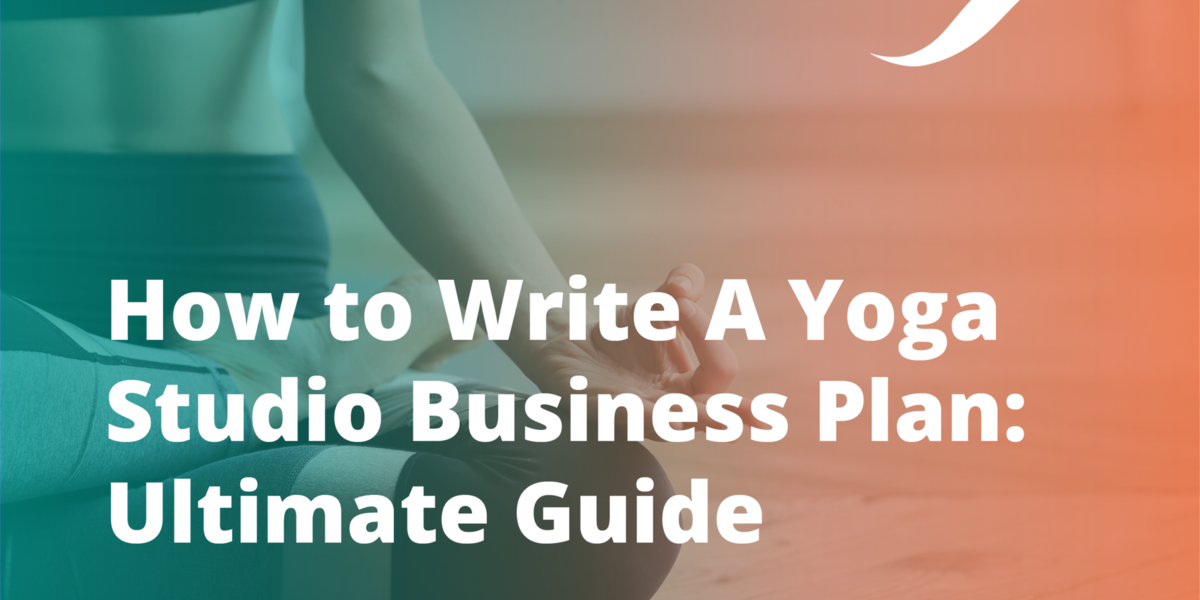How to Write A Yoga Studio Business Plan: Ultimate Guide
If you want to know how to write a yoga studio business plan for your own space, we’ll run through what to include, step by step, so you know exactly what to include!
In this article we’ll cover:
- Why Do I Need a Yoga Studio Business Plan?
- Step 1: Starting a Yoga Studio Business Plan with a Summary
- Step 2: How to Make a Business Plan for a Yoga Studio Including Details of Your Qualifications
- Step 3: How to Write a Business Plan for a Yoga Studio: Include Market Analysis
- Step 4: Highlight Exactly What You Sell in Your Yoga Studio Business Plan
- Step 5: Perform a SWOT Analysis for Your Yoga Studio Business Plan
- Step 6: You Should Include Marketing Strategies in Your Yoga Studio Business Plan
- Step 7: Your Business Plan for a Yoga Studio Should Include Financial Plans and Projections
- Step 8: Conclude Your Yoga Studio Business Plan with a Closing Statement
Before we start, enquire about our Level 4 Yoga Diploma to learn how you can take your career to the next level. Alternatively, check out our guide to how to make money as a yoga teacher.
Looking to Advance Your Yoga Career?
4 Expert Tips to Elevate Your Teachings to The Next Level!
Why Do I Need a Yoga Studio Business Plan?

Before we go into details of how to make a business plan for a yoga studio, we’ll run through why exactly it’s so important to have one.
Having a solid business plan for your yoga studio will help you to organise yourself and understand exactly what you want your business to be and fulfil.
It will also help you to understand where there’ll be challenges and how you can face them in the future, increasing the chances of your business going the distance and adapting to future markets.
A yoga studio business plan isn’t just helpful before you open your space but you can also use it throughout your career as a studio owner, measuring up costs and how well your business is doing compared to projections.
This will help you to adapt your business to allow it to grow as anticipated and meet the demands of your customers and the parameters you set for yourself!
It’s also vital for any potential investors and could make the difference between you securing funding from them or securing a business loan.
It will give others an impression of how you will use your money to return people’s investment and make a profit.
Essentially this is your opportunity to illustrate to yourself and other potential investors how you intend to make money from your yoga studio.
This is why it’s so important when you’re opening a yoga studio to have a business plan that’s as detailed and thorough as possible.
Now that you know why you’ll need one, we’ll get into the details of a yoga studio business plan and what exactly you should include.
Step 1: Starting a Yoga Studio Business Plan with an Executive Summary

A business plan for a yoga studio should always start with a summary for any potential readers or investors to give an overview of your business.
This should cover all the essential information about your potential studio including:
- Who you are
- What kind of classes and services you’ll offer
- How it fills a gap in the market or compares to existing studios
- The state of your finances and health of the business based on your financial projections
- Your goals and how you intend to achieve them
This is your chance to showcase your business and show in a concise and accessible way why it will be a lucrative and successful studio.
You can summarise what’s to come in the rest of your yoga studio business plan and show that you’ve done your research and written a thorough outline.
Despite this section being at the beginning of a yoga studio business plan, this should actually be written last so that you can source the information from the rest of the plan!
This way it will act as a true summary of what’s included and you can speak to specific sections of the finished product.
Ideally this should be under two pages as you’re not including too many details here you’re just offering a brief overview.
You want to detail what will be included without going into the nitty gritty too early! You can signpost to the sections which include further details whilst offering an engaging and readable summary.
The best way to start if you’re struggling is to take one or two sentences from each section and reword them in a concise way to structure this section.
Step 2: How to Make a Business Plan for a Yoga Studio: Include Details of Your Qualifications
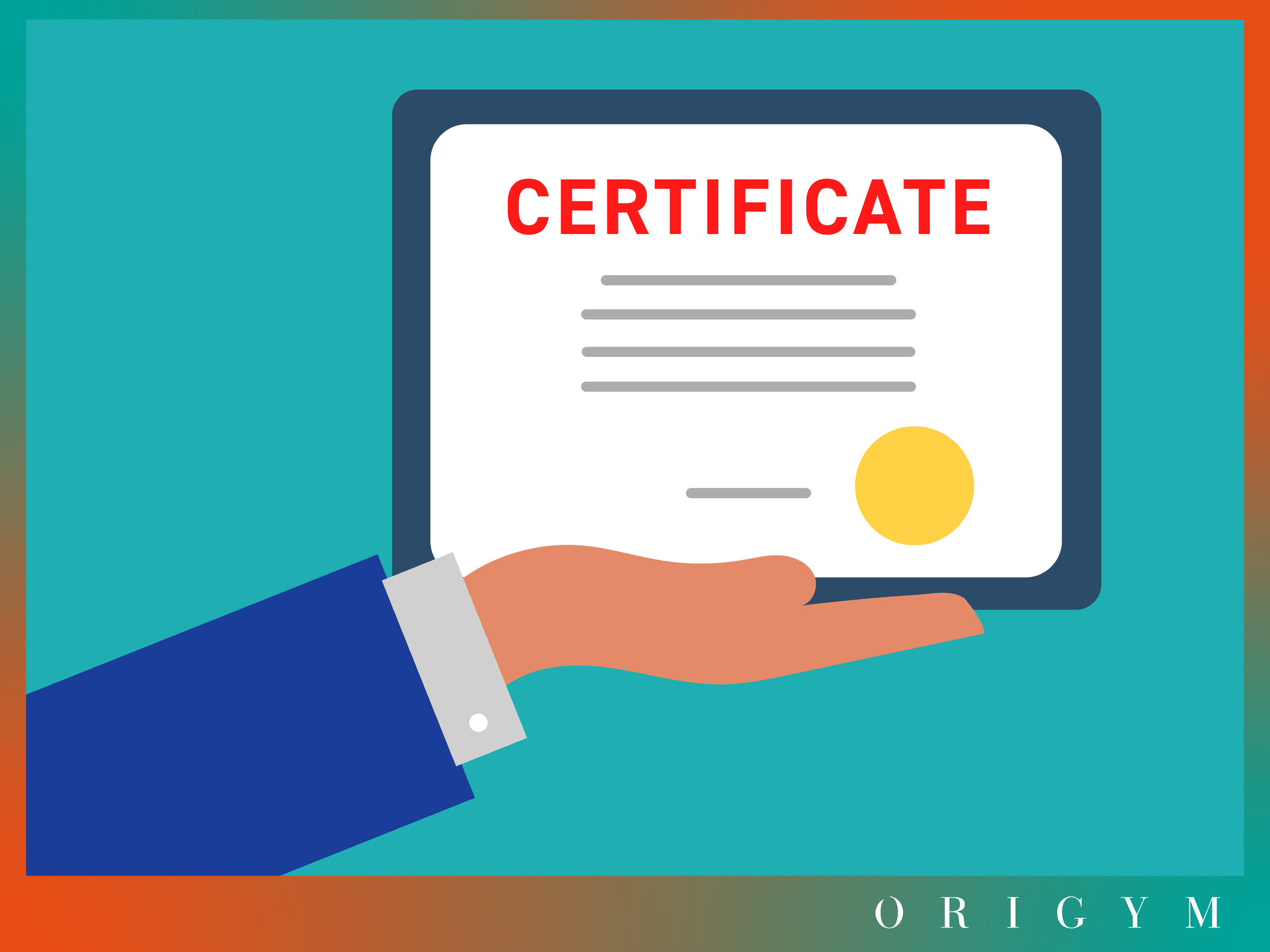
The next section in your yoga studio business plan should detail your qualifications to show why and how you’re equipped to run your proposed studio.
This list will signal to potential investors or anyone reading and funding your business that you’re qualified to do what you set out to do.
All of the yoga teacher training qualifications you detail here will show your capacity as a teacher.
For example, the industry standard for a holistic yoga teaching course is 200 hours whereas a Level 3 Yoga Diploma like ours will include 400 yoga teacher training hours.
This is why you should include the amount of hours you have as well as just the kind of training because this will reinforce your level of expertise and how experienced you are.
Also some foundational yoga qualifications like ours will allow you to specialise in a particular style.
For example, if you’ve completed Level 3 to become an ashtanga yoga teacher and want this style to be the focus of your studio, mentioning this qualification will support your studio’s mission and brand identity.
Advance your yoga career with OriGym! Become a master yoga teacher with our Level 4 Yoga Diploma
You should also detail if you’re qualified with a Level 4 Yoga to illustrate that you’re an advanced teacher and can potentially offer more than existing studios.
You should include your list of qualifications and where you obtained them too so that your readers can see that your training has come from a reputable source.
You should include details of any further fitness qualifications too that aren’t necessarily explicitly yoga related.
For example, if you’re opening a yoga and wellness studio you might have completed other personal trainer courses such as a Level 4 Nutrition course.
Even if these don’t strictly speak to what you’ll offer from your studio this will show potential investors and readers that you’ve got a broad understanding of the health and fitness industry.
It could also potentially form part of your future projections or how you see your studio potentially expanding.
For more information about the different qualifications you can take, and the knowledge and expertise they provide, check out our article about yoga teacher levels here.
Step 3: How to Write a Business Plan for a Yoga Studio: Include Market Analysis
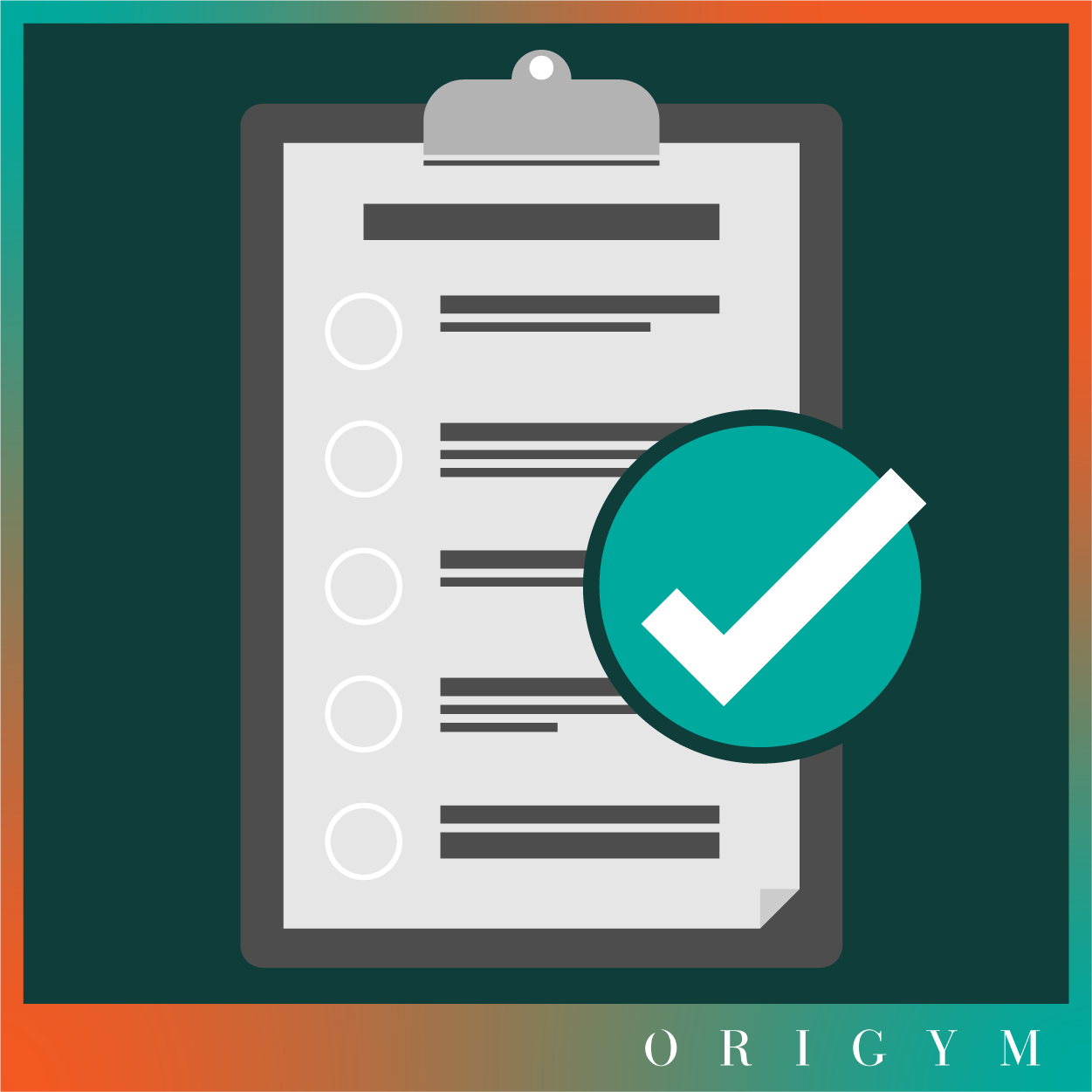
The next section of your yoga studio business plan is market analysis. This is where you’ll look at the existing market, specifically in your location, and how you fill a gap in the market.
This will be one of the most substantial parts of your yoga business plan because it will detail your understanding of the yoga market from pricing to customer base.
It’s vital for showing why your business will be a success and how your studio will stand out against the competition.
This also shows you’re aware of what you’re up against and that you’re aware of what succeeds in the yoga industry.
It’s one of the main ways too that you’ll be communicating your brand identity and your particular unique selling point to readers and investors.
This section should include details of the following to illustrate your awareness of the market and where you fit into it:
- Popular styles in your location
- Services offered by competitors other than classes such as retreats and workshops
- Size of different studios
- Target demographic in terms of age, schedule, and budget
- Pricing options
- Trends and growth rates
Detailing these things will signal to the reader that you’re aware of exactly what you’re up against and where you see your studio filling a gap.
For example, looking at a few different studios in Manchester gives you an impression of the average price for single sessions and monthly subscriptions.
Yoga Soul offer a mixture of subscription options as well as the price of a single drop in session:
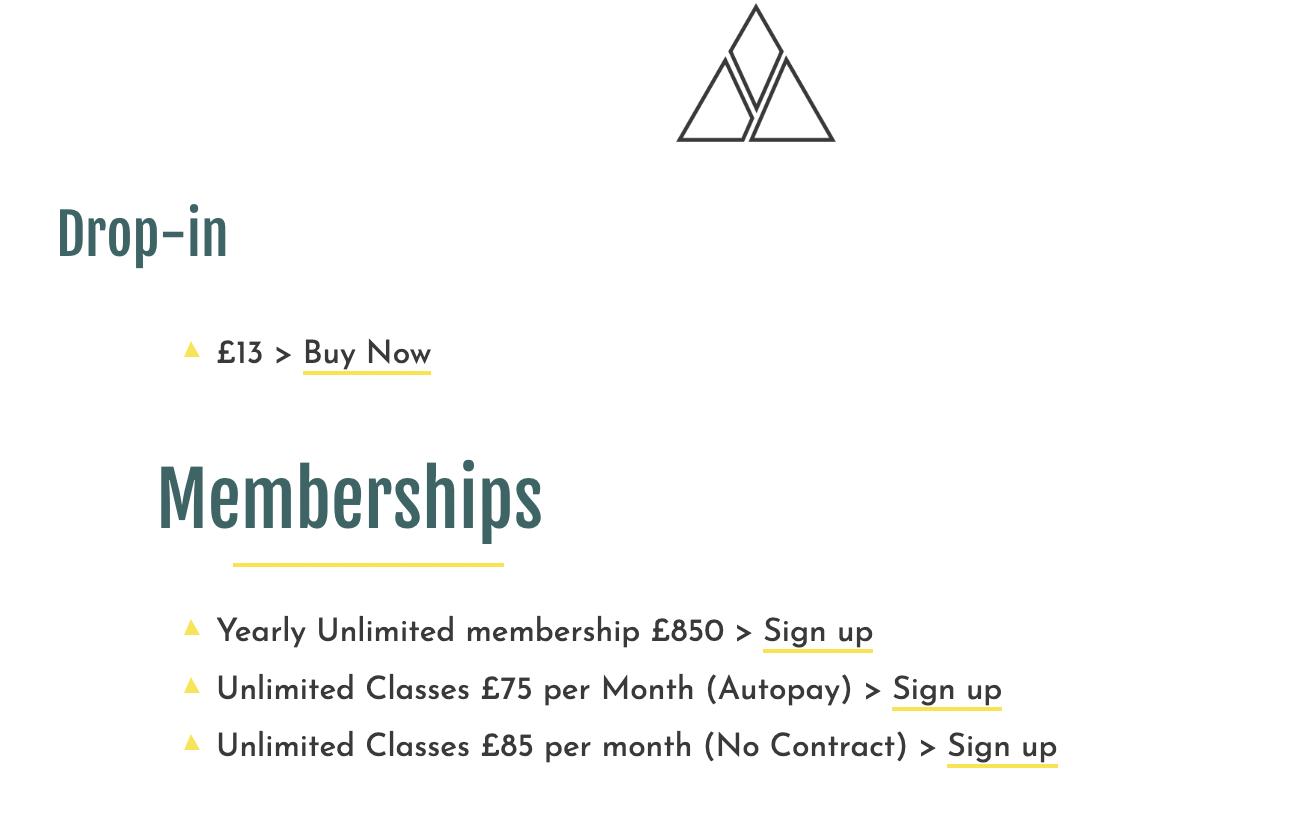
This doesn’t just give you an idea of the different prices they charge for different options but also the pricing structure on offer whether that’s a full year’s membership or a rolling contract.
The price of a single session is around the same as Form with a difference of only a pound:

In terms of subscription services, though, they’re quite different. Form has different monthly subscription options based on the amount of classes people want to take:
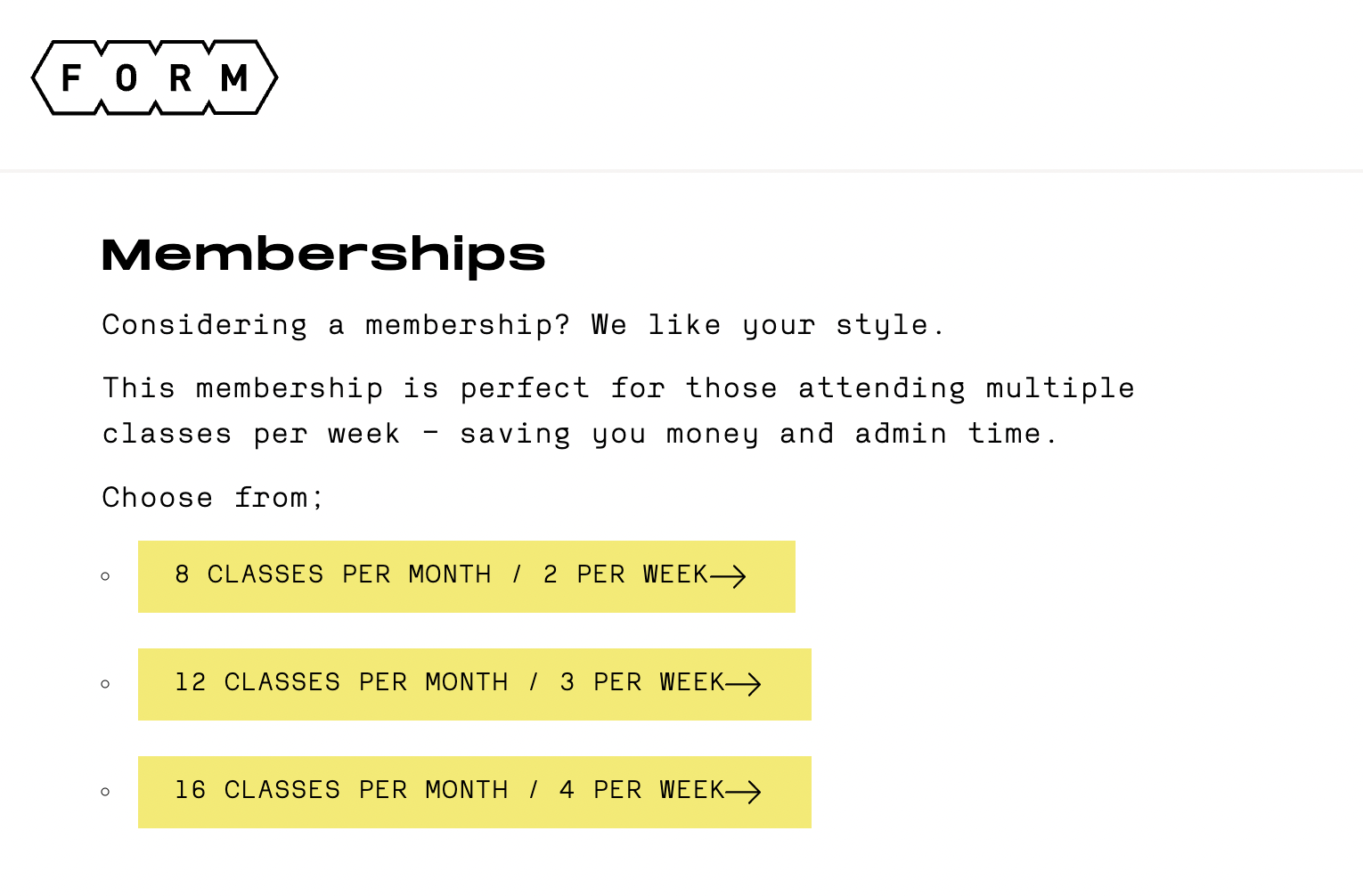
These range from £65 to £125 and so there’s a variety of different structures to meet the needs of potential customers. This can often overwhelm the customer though so may be something you want to avoid.
This is why it’s important to do this research for your yoga studio business plan and your business as a whole because it will help you decide on how to structure your options as well as just pricing individual sessions.
You can compare the options and see what the average is as well as what’s being offered by the studio who’s your most direct competition.
This won’t necessarily mean beating your competitors by being cheaper.
If there’s no boutique or high end option in your area, and there’s a demand for it, this can be something you reflect in the pricing and what you offer in your yoga studio business plan.
Become a Yoga Teacher with OriGym!
Step 4: Perform a SWOT Analysis for Your Yoga Studio Business Plan
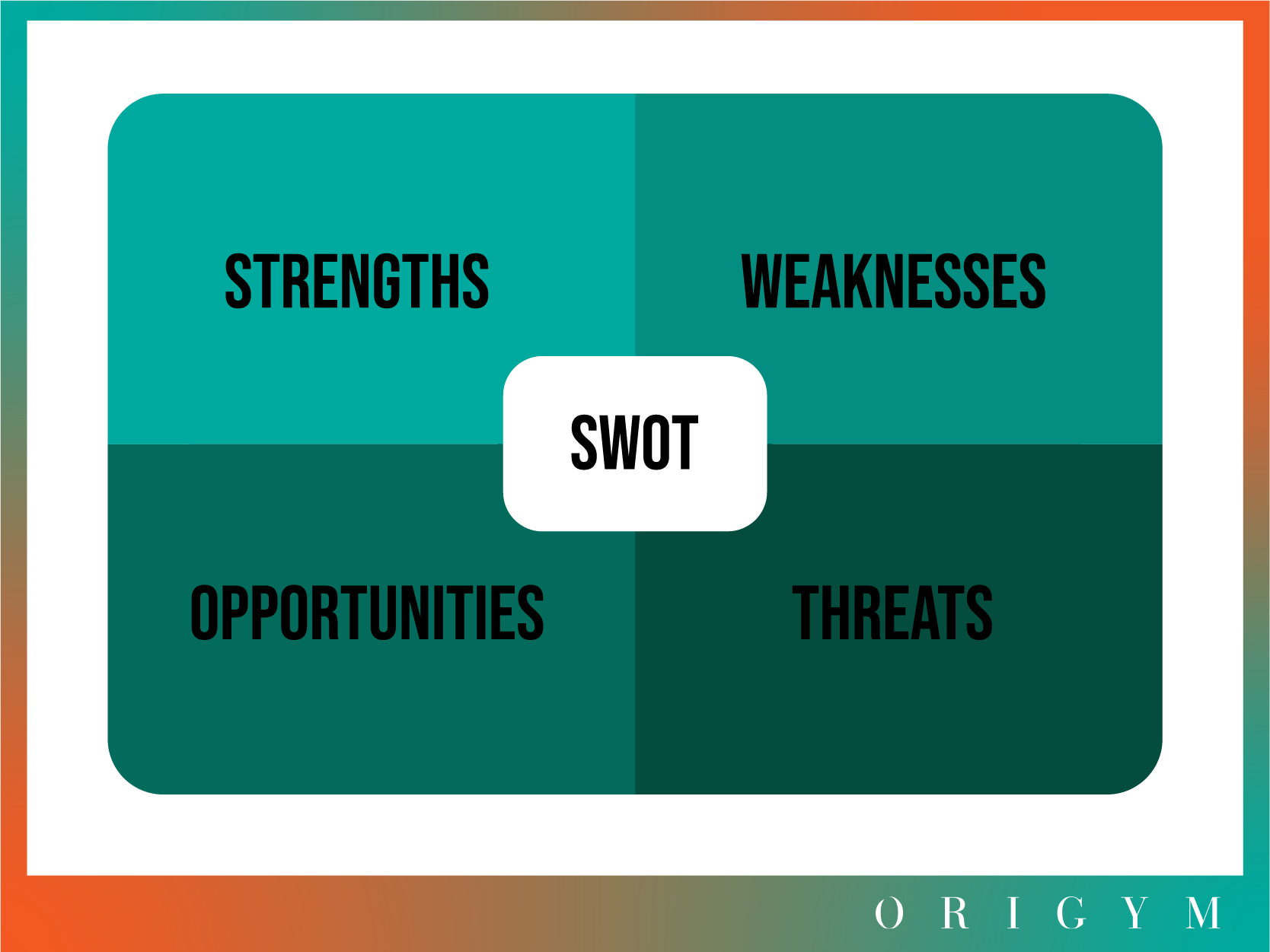
One of the best ways to scope out your competitors in your yoga studio business plan and show how your business will fit into the market is to perform a SWOT analysis.
SWOT stands for:
- Strengths - This is how you show your studio’s value in your yoga studio business plan, highlighting what sets you apart from the competition and what your unique selling point is
- Weaknesses - These may just be things you’re less confident with or areas you don’t specialise in that potentially let you down
- Opportunities - Now you outline how you intend to address those weaknesses as well as opportunities for development of your brand and business
- Threats - This is probably the most important part for comparing yourself to your competitors as you’ll look at what could stop you taking those opportunities
If you want to know how to make a business plan for a yoga studio stand out to investors and readers, this will show you’re fully aware of your competition and exactly how your business fulfils a need.
It also shows that you’ve considered any stumbling blocks and have foreseen anything you may need to overcome in order to be more successful in terms of the weaknesses and threats.
For more details and information about this process check out our dedicated article on personal trainer SWOT analysis.
Step 5: Highlight Exactly What You Sell in Your Yoga Studio Business Plan

This part of the yoga studio business plan is to illustrate fully what it is that you’ll offer in your studio and the different revenue streams you’ll have.
This shouldn’t just be a list of the classes you’ll offer but any way you plan on making money from the studio.
This list of different facets of your business will naturally continue on from your market analysis. Here you’ll be reinforcing how your studio will be filling a gap in the market and why what you’re offering is unique.
It will also reinforce your awareness of the market because there’ll be certain things that you’ll include based on your research and what are some top priorities for a yoga studio.
Your business plan should therefore include details of:
- What styles of yoga you’ll offer
- The range of abilities you’ll cater for
- How much you’ll charge for classes
- Other revenue streams such as refreshments or mat and towel rental
This can show a level of growth with the studio rather than just what you’ll offer immediately and this can form the future projections for your yoga studio business plan.
For example, you might project that you’ll rent your space to other teachers in the future for workshops and special events, adding a new revenue stream once you’ve grown your brand and reputation.
Some of these projected events and services will depend on the success of your classes and other main revenue streams.
This section is your opportunity to show why they’ll be lucrative enough to support future ventures and how your pricing and services will grow your business!
---------------
If you’re finding this article helpful, check out some of our others about developing your business:
- How Much Should You Charge for Your Yoga Classes?
- How to Get More Private Yoga Clients: Ultimate Guide
- 9 Key Challenges of Running a Yoga Studio (& How to Overcome Them)
Step 6: You Should Include Advertising & Marketing Strategies in Yoga Studio Business Plan

Before opening a yoga studio your business plan should include a section on how you intend to use marketing to promote your services and boost membership.
This will show anyone funding the studio that you intend to have a high ROI (return on investment) and how you’ll get it.
The strategies you choose will be informed by who your ideal customer is because each platform will be used most by different demographics.
There’s a few staple strategies you should use though that will be vital to detail in your yoga studio business plan:
- Social media content
- SEO (Search Engine Optimisation)
- Paid ads on Google and social media
- Getting registered on Google my business
- Email marketing
We’ll run through these strategies briefly and show you what you should include in your yoga studio business plan for each.
You can find a list of further hints and tips in our article on digital marketing for a yoga business here.
Include Social Media Content Plans in Your Yoga Studio Business Plan

Social media is an essential tool for any marketing strategy mainly because of its reach and how many people are on the platform at any given time!
You might propose to utilise the following platforms for marketing strategies to reach different audiences and gain more studio members:
- TikTok
Depending on your target demographic you’ll focus on different platforms accordingly. For example, according to Statista the age group that makes up the majority of Facebook users is 25 - 34 year olds.
This is one of the older brackets of social media users. By comparison, most TikTok users fall somewhere between 18 and 24 according to Oberlo.
This is why it’s something you should bear in mind when you’re proposing the kind of content you’ll produce and the platforms you’ll use!
Looking to Advance Your Yoga Career?
4 Expert Tips to Elevate Your Teachings to The Next Level!
Your options for the kind of content you can use in your marketing strategies includes:
- Organic content (unpaid and unsponsored content you create) including reels, stories, and posts
- Paid content such as ads and sponsored posts
You can use ads to target your demographic with ads running on people’s feeds, reels, and stories.
For ideas about what kind of content will work best for you and what to include in your yoga studio business plan you can check out our article about yoga Instagram marketing and how to create fitness Facebook ads.
Writing About SEO in Your Yoga Business Plan

SEO, or ‘search engine optimisation’, is the process through which you optimise your web content so that you rank highly on Google, making it easier for people to find your services!
Features of SEO you’ll need to consider and write about in the business plan for your yoga studio include:
- High quality content on your website or landing page
- Using keywords in your content
- Get other websites to link to your site
- Internal links from one page to another on your site
If you want to know how you should include these in your yoga business plan you’ll need to say how you propose to spend your budget on SEO.
This might include projections about the kind of software you’ll need in order to create high quality content or search for the right keywords.
Keywords, or ‘search terms’, are what people type into Google when they’re searching for a particular service.
Tools such as Semrush and Ahrefs are paid services you can use to do this kind of research and so you may want to include this as part of your budgeting!
You can find out more about each of these and how you can utilise them for your yoga studio business in our article on SEO for yoga teachers.
Mention Paid Ads in the Marketing Section of Your Yoga Studio Business Plan

As we’ve already mentioned, you should detail how you’ll use social media advertising as part of your marketing strategy in your yoga studio business plan.
Google ads are the other kind of paid advertising you should consider using as part of your marketing strategy and the budget of your business plan.
For a yoga studio, using these ads is one of the most significant ways you can secure a better ranking on Google’s search results page.
Designing a strong ad and ranking well with it will employ some of the SEO skills we mentioned earlier, choosing keywords and search terms to target to reach your ideal customer.
You set a budget based on this with keywords varying in cost based on the strength of your site and how often they’re used or how competitive the words are.
You can also decide how you want your ads to work in terms of what outcome you want and what action you want people to take.
You’ll want to choose pay-per-click which means you only pay when the ad has worked and people have found it and clicked through to your desired web page.
For more information on this style of advertisement and how you can budget for them in your yoga studio business plan, read our article on yoga Google ads.
Mention Google My Business in Your Business Plan for a Yoga Studio

Google My Business is another tool that will help display your yoga studio highly on the search results page when people are searching for specific locations.
For these local searches, i.e searches on Google that contain a location, the top three results will be the ‘local three pack’ which are three Google My Business Listings.
Here’s what it looks like for the keyword ‘yoga studio Leeds’:
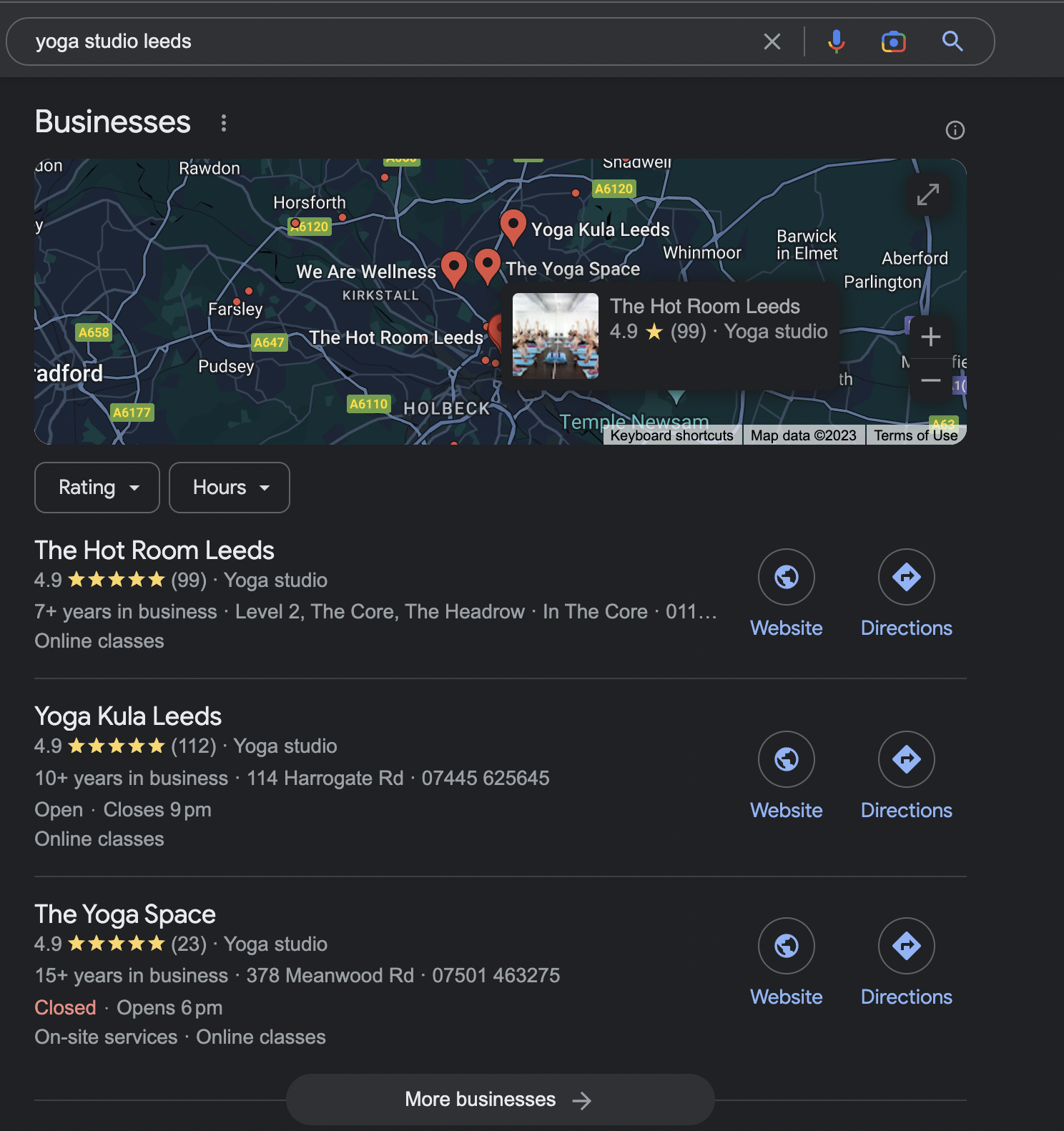
As you can see these Google My Business listings will tell people the following about your business in one convenient place:
- Location
- Opening hours
- Contact information
- Website details
- Address
This is why it’s such a useful tool for your yoga studio and your business plan because this is another way you can secure sales.
People making local searches are what’s called “high intent” meaning they’re searching with a greater intent to sign up for a service rather than just wanting to learn about something.
They’re specifically looking for a studio in their location usually and so are more likely to become customers!
This is why your business plan for a yoga studio should include this as a strategy as it’s another way to reinforce that you know how to reach your demographic and get people to sign up!
It’s also completely free! So you can target your ideal customer without having to worry about where it fits into your budget.
Our article about how PTs can use Google My Business contains plenty of tips and help that will be relevant for your research and your business plan!
Become a Yoga Teacher with OriGym!
Discuss Email Marketing Strategies in this Section of Your Yoga Studio Business Plan

Last but not least, when you’re starting a yoga business your business plan should include details of email marketing in your projected strategies.
Email marketing is when you’ve used some of these other marketing methods to obtain potential customers’ email addresses in order to market directly to them!
The most popular and easy ways of getting people’s email address following GDPR include:
- Offering a resource on your website such as an instructional video for free where people provide their email addresses to be sent the resource
- Confirmation emails for classes. You can ask people to opt in or out of receiving further marketing materials when they book on
- Offer a newsletter will allow people to stay up to date with everything you offer and allows you to showcase your business
The benefit of this particular marketing strategy is that you will be speaking to people as directly as possible, straight into their inbox!
Mostly you’ll be sending your email marketing to people who’ve opted to receive information from you and are either interested in attending more classes or are leads for upselling your subscription services.
The reason you should include this in the business plan for your yoga studio is that it’s another way you can secure leads and will also influence your budget as you may need to use paid software.
You can use free versions of Mailchimp to design a yoga newsletter and then later pay for more advanced tools to measure the metrics of your campaigns to improve them as you go.
There’s plenty more information about things you should include in your strategy in our dedicated article on fitness email marketing.
Show the Impact of These Strategies in Your Yoga Studio Business Plan

If you’re starting your own yoga studio chances are you’ve been a practising teacher for a while and may have developed your own marketing strategies.
This is why you should include any impact you can show in this section of your yoga business plan.
You might include the reach that certain organic content has had on platforms like Instagram or show any leads already generated by paid ads.
This will help you to secure funding by showing successful strategies in the past and showing how money will be used.
If you can show that you’ve implemented some of these strategies to success already, this legitimises their place in your budget.
It also asserts that you can be trusted to provide a return on investment and will implement lucrative strategies.
You can include screenshots of some of this information in your business plan. For example, here’s a screenshot of the leads generated by our own social media ads in a month:
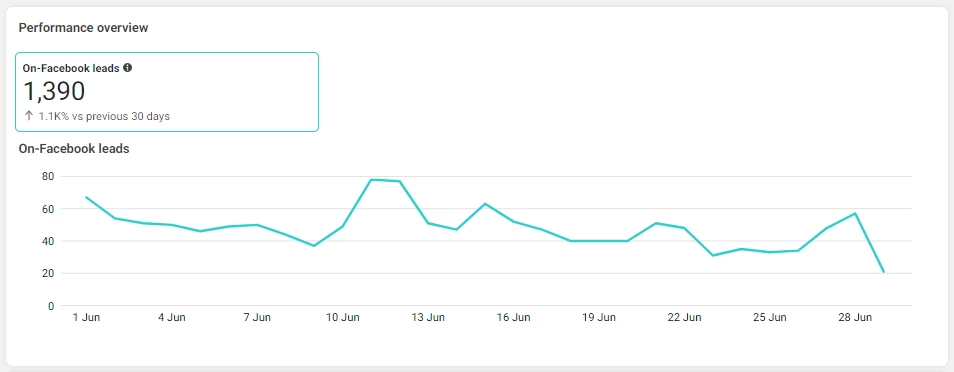
You can then show a break down of what was spent in order to generate those leads like this:
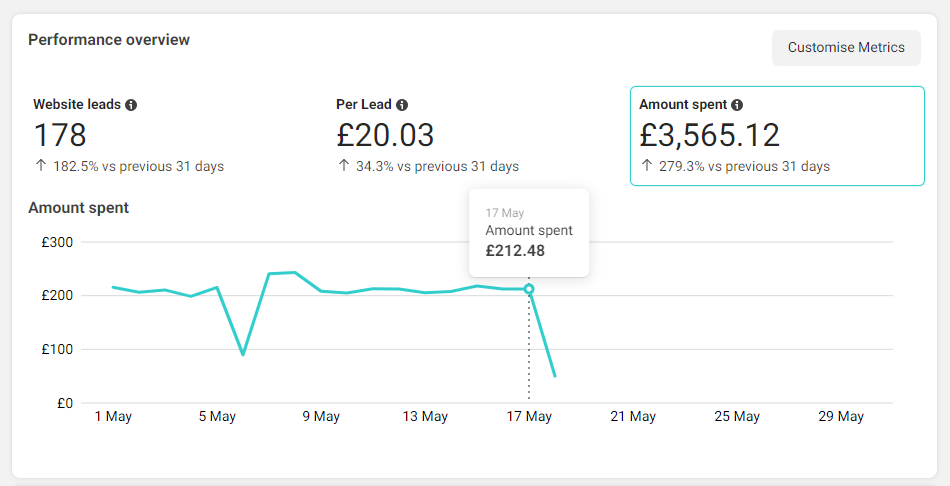
However, if you’ve been working for a gym or some other facilities you may never have had to do your own extensive marketing before.
If this is the case then you should include these in your financial plans and projections as part of your market research about what has worked for other people and in any studies you can find.
We’ll look at the financial section of your business plan for a yoga studio now!
Step 7: Your Business Plan for a Yoga Studio Should Include Financial Plans & Projections

Though it’s hard to say any one section of your business plan is more important than another, your financial plans and projections are certainly up there!
This is the section of your yoga business plan where you’ll run through all of your costs and how you expect to make a profit and your projections for the amount of time that might take.
You should include details of all of the following in this section:
- Costs of starting the studio and opening including equipment you’ll need, licences, and the cost of renting the space itself
- Operating costs for the first few. This will continue on from the previous point and include details of how you’ll pay to operate and run your business for three financial years
- Whether you’ll hire any staff. This will affect your insurance as well as just the cost of paying wages so will affect your budget as a whole
- The amount of classes you’ll have and how much you’ll pay yoga teachers for them. You’ll most likely be paying a variety of different freelance teachers as well as teaching your own classes so you should say how much
- Costs of marketing strategies including any budgets for some of the things we mentioned above such as software used for email marketing, Google ads, and social media ads
Advance your yoga career with OriGym! Become a master yoga teacher with our Level 4 Yoga Diploma
The reason all of this is so important is that it’s your way of sticking to your own budget and knowing exactly how much things will cost.
This will help you get an idea of how much money you’ll need and how you intend to get a return on your own or somebody else’s investment.
It also shows potential investors that you’ve got projections for how much money you can make and when.
This shows them that you understand your finances and are a worthy investment and know how to run a successful yoga studio.
It’s not just important to cover all of the above bases but they should also be formatted in a certain way, included in three vital things:
- An income statement
- A balance sheet
- A cash-flow statement
We’ll run through each of these briefly so you know exactly what they are and what you’ll need to include.
An Income Statement

This will be based on some of your financial projections and will show how much money you make after expenses in your projected first few months or year of being in business.
It will show the revenues and expenses of the business and the profit or loss that results from this.
This is good practice because it’s something you’ll continue to do regularly, at least every quarter, in order to stay on top of your finances and for your taxes.
This is called a ‘periodic’ income statement but the one you’ll include in your yoga business plan is called a ‘pro forma’ one as it’s based on projected expenses and profits.
Creating an income statement will also inform other sections of your plan. For example, this will help you iron out any problems and actions you can take to help your finances in your SWOT analysis.
When you’re starting out you should continue to do these statements every month for a year rather than every quarter so that you can consistently track your progress and returns on investment.
A Balance Sheet

A balance sheet is a run down of what you have versus what you owe and what’s left after you deduct one from the other.
Essentially this means the assets you have, or things that could be liquidated and turned into cash, versus liabilities, which are funds owed.
Your assets will either be ‘current’, meaning they can easily be liquidated into cash, or ‘noncurrent’ which will be things that can’t as easily be converted into cash such as land or leases.
When you’re starting your yoga studio business plan this will include the equipment you’ll own for your studio and any long term business leases for the space itself.
These funds will usually be a mixture of short liabilities owed within a year including:
- Supplier invoices
- Wages
- Income tax deductions
- Utilities
And long term liabilities which are due after one year including:
- Deferred tax liabilities
- Any long term debt such as interest on loans
- Pension fund liabilities
Liabilities when you’re starting your yoga studio and your business plan will mainly include any loans or things you’ve bought on finance.
Then you’ll have the ‘equity’ in a third column which gives you and any potential investors an idea of the financial health of your business.
This is what remains after deducting the liabilities from the assets!
A Cash-Flow Statement

The cash-flow statement is similar to an income statement but instead of just showing how much money has been earned and spent this gives an idea of how much cash is on hand at any given time.
The form that this takes and the information contained will depend on the kind of accounting you’re proposing to do.
Accrual based accounting records income and expenses when they’re spent and incurred respectively.
For example, you would record income when somebody new signs up for a studio subscription rather than specifically when that money actually enters your business account.
Even though you may be able to predict and project the amount of subscription signs up in your first year, it doesn’t necessarily reflect how much cash you’ll have at a given time.
Cash flow statements will build on your ‘pro forma’ income statement to predict how much money you will actually have.
This is another thing that you’ll regularly have to do when you’ve opened your studio and will inform how you operate.
For any potential investors and other funding bodies this shows your business’s projected liquidity (or money you can actually spend and will have access to).
This means you’ll be able to show how much cash you’ll have should you need it and what you can afford to do as a result.
This is why it’s vital and will inform other parts of your yoga studio business plan because you’ll be able to show what you can and can’t spend and that you’re financially prepared for unforeseen costs.
Step 8: Conclude Your Yoga Studio Business Plan with a Closing Statement

Just like the way we suggested starting a yoga studio business plan, you should end it with a summary of everything that’s gone before.
This is where you’ll go over the previous sections briefly speaking to how they indicate where your business is up to and what the most important next steps are.
Looking over your business plan and writing this summary will help you decide on and prioritise these next steps.
This also indicates to potential investors and anyone else reading the business plan that you’re aware of how to act on the previous sections and advance your business.
You should reinforce your brand identity, focus on how your strengths will lead to success, and how you intend to deal with any obstacles identified!
Before You Go!
That concludes our article on how to write a yoga studio business plan! Hopefully now you feel prepared and can start writing the perfect plan for you and your business.
Don’t forget to check out our advanced yoga teacher training courses so you can increase your experience and sell yourself and your expertise in your business plan.
You can also download our guide below for how our Level 4 will help develop your career!
Looking to Advance Your Yoga Career?
4 Expert Tips to Elevate Your Teachings to The Next Level!
